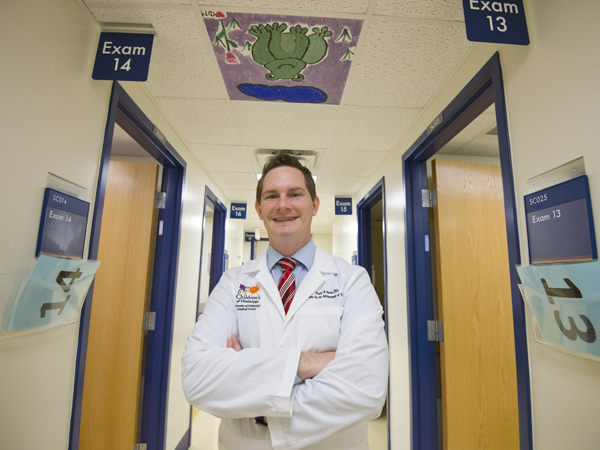Researcher: Hyperactive movements help ADHD children learn

A common symptom found in children with attention deficit hyperactivity disorder (ADHD) - and one long believed to be a main hindrance to a child's development - actually could be a learning trigger.
In a study published April 12 in the Journal of Abnormal Child Psychology, researcher Dr. Dustin Sarver and colleagues discovered the hyperactive movements associated with the disorder may allow children with ADHD to enhance their cognitive abilities.
Sarver, who studied the issue while completing his Ph.D. in Clinical Psychology at the University of Central Florida, now works at the Center for Advancement of Youth (CAY) at the University of Mississippi Medical Center. The findings he helped unearth are ones he said could have an impact on how children with ADHD are taught in classrooms here in Mississippi and the treatments they receive - two of the main goals of the CAY.
"Previous research with my mentor and our colleagues shows that when kids with ADHD are given very demanding cognitive tasks involving working memory, they become more hyperactive. But when we don't put demands on their working memory, they're no more active than kids without ADHD," said Sarver, an assistant professor of pediatrics at UMMC.
"This new research asked the next question — does that movement help or hurt their working memory?"
Working memory, unlike the more commonly known short-term memory, is a higher-level executive function employed when a person must manipulate and process information to arrive at a conclusion, explained Sarver. Working memory is critical for completing complex tasks and learning.
"If I gave you my telephone number, you would use short-term memory to recall it," he said. "If I had you rearrange those same numbers in order, then you're using working memory."
Those were the kinds of tasks children in the UCF study were asked to complete, while researchers observed their movements using high-speed video, he said. For the majority of kids with ADHD, the more they moved the better their working memory performance. In contrast, children without ADHD typically did worse when they moved more.
By allowing the hyperactive behaviors to continue, children with ADHD are able to increase their arousal and remain alert in the classroom. Yet conventional teaching and treatment methods demand ADHD children remain still, and the ability to focus on the lesson is lost in the child's struggle to focus on not squirming or fidgeting, said Sarver.
"This movement has a positive purpose," said Sarver. "As long as they are engaged and not disrupting others, we facilitate it, because it helps maintain alertness. The moment we stop them from moving, I find that they concentrate more on stopping their movement instead of using their cognitive abilities to pay attention for learning."

The implications of the study could have a large impact on a state that has more than double the percentage of children diagnosed with ADHD than the national average, said Dr. David Elkin, professor of psychiatry at UMMC and the CAY's executive director.
"The average rate of ADHD in any state population is about 5 percent," said Elkin. "Mississippi, according to Medicaid statistics, is 11 percent. So the question comes: Why do we have twice the number of kids diagnosed with ADHD across the state? There are probably several answers.
"One is poor assessment where these children are not properly assessed and diagnosed, where anything that looks like ADHD gets called ADHD. Consequently, Mississippi via Medicaid spends a huge amount of money per child with ADHD."
Elkin said applying Sarver's findings could revolutionize how classrooms operate, how ADHD is understood and how ADHD assessments and treatments are conducted — all potentially saving money while offering more efficient care for these children and their families.
Shelley Ezelle of Hattiesburg works with children with special needs.
.jpeg)
Hills Ezelle, 4
She also has a son named Hills who has now been diagnosed with ADHD.
"The teacher at his school started talking to me (about having Hills evaluated) at the beginning of the school year," she said. "By the middle of the year, I decided to go through with the evaluation."
Hills was diagnosed with ADHD, and after understanding her four-year-old child needed specialized treatment, a list of referrals brought her to the CAY and Dr. Sarver.
"One of our recommendations was to ask the school to allow him to move while learning as long as it didn't disrupt any other children around him," said Ezelle. "With my background working with children's behavioral issues and the willingness of his teachers, we have figured out a way that he learns best."
.jpeg)
Shelley Ezelle and her son Hills, 4
For example, Ezelle said the more Hills is allowed to be the teacher's helper in class, the more engaged he is in with his work.
"We know he's going to learn the more he's able to have the hands-on approach," said Ezelle. "Dr. Sarver's study, it's dead on. It's how we need to work with children with ADHD in the school system."
Sarver said he hopes to be able to use his findings to help children with ADHD and their families better understand the disorder by highlighting positive aspects of ADHD that show hyperactivity can be a compensatory mechanism that helps them learn.
Previous findings, he added, show as children grow and their working memory improves, patients tend to see decreases in ADHD symptoms into adulthood and that treatments are needed to accelerate this process.
"I'm hoping to parlay this (study) into working better with parents, teachers, and schools," said Sarver. "In Mississippi there is a dire need for improvement, and hopefully this will be an avenue to increase the ways the Medical Center and our educational system interact to improve outcomes for children with ADHD."

Co-authors with Sarver include: Mark D. Rapport, University of Central Florida; Michael Kofler, Florida State University; Joseph Raiker, Florida International University; and Lauren Friedman, University of Central Florida.
By The Numbers
According to Medicaid, Mississippi has an 11 percent incidence of children with ADHD, more than double the national average of 5 percent.
In Mississippi:
- 43,000 children currently are diagnosed with ADHD
- Medicaid spends an average of $4,471 per ADHD child each year
- Medicaid spends an average of $1,000 per well child each year
- Reducing the costs of ADHD patients by 20 percent could save $43 million per year


